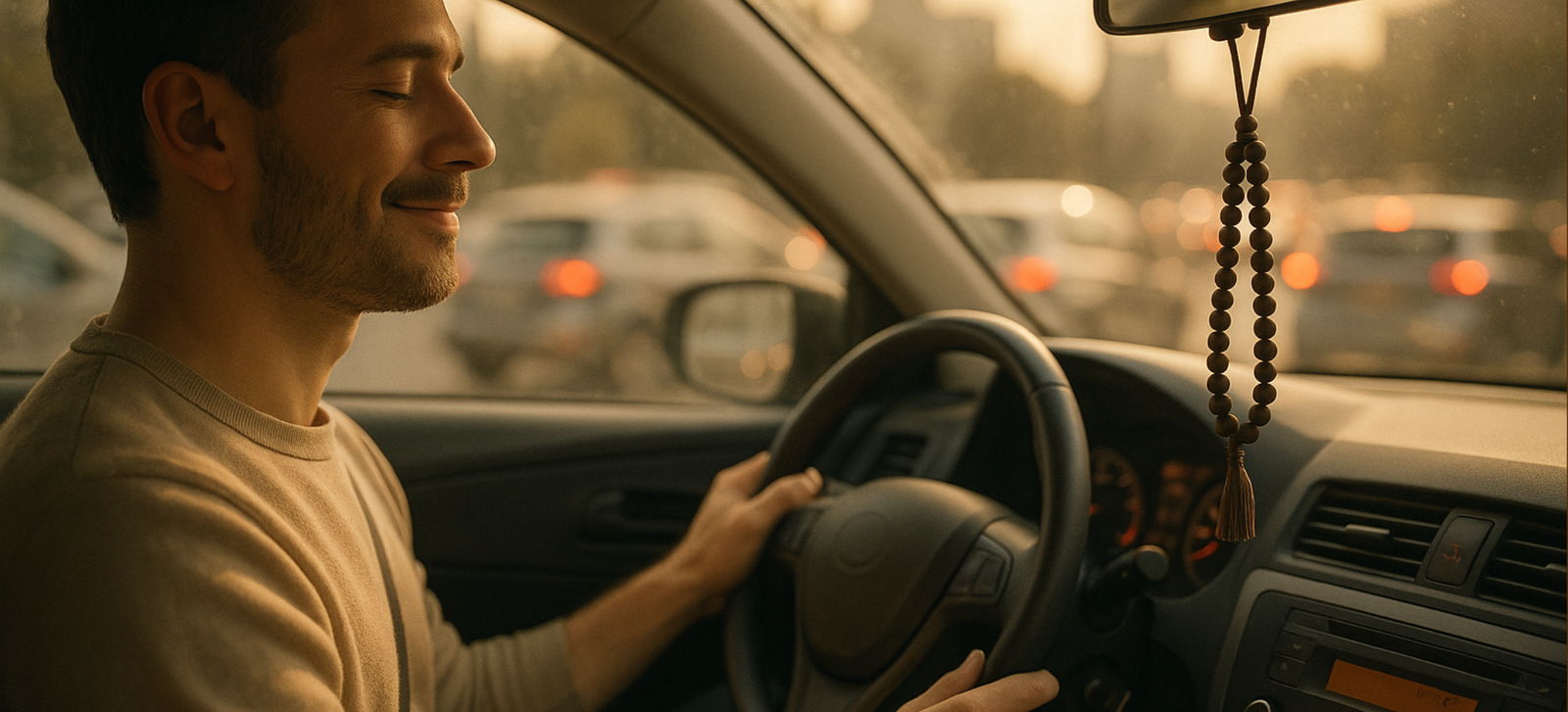Transform daily traffic jams into powerful meditation practice. Learn mindfulness techniques that reduce road rage and turn commute stress into inner calm.
Yesterday, I sat motionless on the Pune-Mumbai Expressway for forty-seven minutes. The usual suspects were there—honking auto drivers, the BMW trying to squeeze through non-existent gaps, that one uncle gesticulating wildly at the traffic gods. But instead of my typical internal rage spiral, something different happened. I found myself breathing deeper, noticing the chaos without drowning in it, and actually arriving at my destination calmer than when I left.
Here’s what nobody tells you about traffic jams: they’re perfect meditation halls disguised as torture chambers. Every honk is a bell, every delay is a reminder to let go, every moment of forced stillness is an invitation to practice the one skill we desperately need but rarely develop—the art of being present with what we cannot control.
Key Insights:
- Traffic jams offer natural opportunities for mindfulness practice in everyday life
- Transforming driving stress into meditation reduces road rage and improves mental clarity
- Simple breathing and awareness techniques can turn commute time into personal growth time
Why Traffic Is Actually the Perfect Meditation Teacher
Let’s face it—traffic in Indian cities isn’t going anywhere except worse. Bangalore has its eternal jams, Mumbai’s trains are sardine cans on wheels, and Delhi’s roads are basically mobile furnaces for half the year. We spend hours of our lives in vehicles, mostly fighting reality and cursing our fellow humans.
But what if I told you that traffic is offering you something precious? Forced presence.
Think about it: you can’t check Instagram (safely), you can’t scroll through emails, you can’t escape into your usual distractions. You’re literally trapped in the present moment with nothing but your thoughts, your breath, and your reactions. As mindfulness teacher Andy Puddicombe puts it, “Turning driving into an opportunity for mindfulness can be done with a simple strategy we call Notice-Shift-Rewire.”
The Notice-Shift-Rewire technique works like this: Notice when you’re getting frustrated, Shift your attention to something calming like your breath, and Rewire by staying with that calmer experience long enough to create new neural pathways.
Research backs this up. Studies show that “mindfulness improves cognitive function and reduces the occurrence of distracting thoughts, which leads to safer driving practices.” When we’re not busy internally screaming at other drivers, we actually become better drivers ourselves.
The Indian Traffic Meditation Method
Here’s the thing about meditating in Indian traffic—it’s not your serene mountain monastery experience. It’s more like learning to surf in a tsunami. But that’s exactly what makes it so powerful.
Step 1: The Pre-Drive Ritual Before you even start the engine, take three conscious breaths. Not the shallow chest breathing of a stressed person, but the deep belly breathing of someone who knows they’re about to enter a battlefield and chooses peace anyway. Set an intention: “I will arrive safely and calmly, regardless of traffic conditions.”
Step 2: The Horn as Meditation Bell Every time someone honks (which in Indian traffic is approximately every 3.7 seconds), use it as a mindfulness bell. Instead of getting irritated, let each honk remind you to check in: “How am I feeling right now? Am I gripping the steering wheel too tightly? Am I holding my breath?”
I started doing this six months ago, and now honking actually helps me stay more present. My friends think I’ve lost my mind, but my blood pressure monitor disagrees.
Step 3: The Traffic Light Practice Red lights become mini-meditation retreats. “Centre your attention on the breath but nevertheless maintain an open mind and an open heart. Allow all the processes of life, including the thoughts, feelings, frustrations and worries to arise and pass.”
Don’t try to stop your thoughts about being late or frustrated. Just watch them like clouds passing through the sky of your awareness. The light will change when it changes, whether you’re stressed about it or not.
Transforming Road Rage into Road Wisdom
Let me be honest—I used to be one of those drivers who took every traffic violation personally. Some guy cuts me off, and suddenly I’m conducting a full character assassination based on his driving choices. It was exhausting and pointless.
The breakthrough came when I started practicing what I call “assumption flipping.” Instead of assuming the worst about other drivers, I started assuming the best. That person who just cut me off? Maybe they’re rushing to the hospital. That slow driver in front? Maybe they’re elderly or learning. That aggressive honker? Maybe they’re having the worst day of their lives.
Research shows this approach works. Studies indicate that “mindfulness elicits flexible responses, avoids irrational assumptions, and promotes focus on present circumstances” which directly reduces aggressive driving behaviors.
Here’s a practice that transformed my commute: loving-kindness while lane-changing. Every time someone lets me merge, I silently thank them. Every time I let someone merge, I wish them well. It sounds cheesy, but it rewires your brain to see other drivers as fellow humans instead of obstacles.
The Science Behind Steering Wheel Zen
You might think I’m just being philosophical about traffic, but there’s solid neuroscience behind this. When we’re stuck in traffic and getting angry, our amygdala fires up, flooding our system with stress hormones. We’re literally poisoning ourselves over something we cannot control.
“Accumulated tension, stress and anxiety can be a time bomb waiting to explode. Get to the root of the problem and eliminate the stress through any approach proven to effectively dissolve stress.”
But when we practice mindfulness in traffic, we activate the parasympathetic nervous system—the rest-and-digest response. Our heart rate slows, our breathing deepens, and our brain literally changes structure. After just eight weeks of mindfulness practice, MRI scans show increased gray matter in areas associated with emotional regulation.
The beautiful irony? By accepting that we’re stuck, we become unstuck emotionally. By surrendering control over traffic, we gain control over our internal state.
Practical Techniques for the Mumbai Local Experience
Different types of traffic require different approaches. Here’s your field guide:
For the Bangalore Bumper-to-Bumper: Practice the “space meditation.” Focus on the spaces between cars, the spaces between breaths, the spaces between thoughts. In the density of traffic, find the spaciousness within.
For the Delhi Heat-Wave Drive: Turn your AC into a mindfulness teacher. Feel the cool air on your skin, notice the contrast between inside and outside temperature. Use physical sensations as anchors to the present moment.
For the Mumbai Monsoon Crawl: Let the rain on your windshield become a meditation object. Watch the patterns, listen to the rhythm. Rain doesn’t care about your schedule—it just falls. Be like rain.
For the Pune Pothole Slalom: Every bump becomes a reminder to soften your grip, both on the steering wheel and on your expectations. Life is bumpy. Resistance only makes it worse.
When Traffic Becomes Your Teacher
After a year of treating traffic as meditation practice, I’ve learned more about patience, acceptance, and emotional regulation than from any formal meditation course. Traffic doesn’t care about your spiritual progress—it just is. And in that uncaring consistency, it becomes the perfect teacher.
The question isn’t whether you’ll hit traffic. If you live in any Indian city, you will. The question is whether you’ll use that time to stress yourself into an early grave or to develop the emotional resilience that actually matters.
Research from Stanford shows that people who practice mindful driving report “increased happiness” and better stress management. They arrive at destinations not just physically, but emotionally intact.
I’m not saying traffic jams are fun. They’re still inconvenient and sometimes genuinely challenging. But they’re also guaranteed daily opportunities to practice the most important skill we can develop: staying calm when life doesn’t go according to plan.
The Unexpected Benefits of Bumper-to-Bumper Buddhism
Here’s what surprised me most about turning traffic into meditation: it started affecting other areas of my life. When my WiFi goes down, I don’t immediately panic. When meetings run late, I don’t internally combust. When plans change, I adapt instead of resist.
Traffic taught me that most of our suffering comes not from external circumstances, but from our resistance to external circumstances. That stuck red light isn’t making you late—your expectation that lights should always be green is making you late.
Students often ask me, “How do I find time to meditate?” I tell them: you already have it. It’s sitting there between your house and your office, between your desires and reality, between your steering wheel and your destination.
The monastery isn’t on some distant mountain. It’s right there in lane three of the Western Express Highway, disguised as the thing you think is wasting your time.
Frequently Asked Questions
Q: Is it safe to meditate while driving? A: Absolutely, when done correctly. Traffic meditation isn’t about closing your eyes or zoning out—it’s about being MORE present and aware. You’re practicing mindful attention to driving, not distracted meditation.
Q: What if I get more frustrated trying to stay calm in traffic? A: That’s completely normal and part of the practice. Notice the frustration without judging it. You’re not trying to eliminate emotions, just change your relationship with them. Progress isn’t perfection—it’s awareness.
Q: How long does it take to see results from traffic meditation? A: Most people notice subtle shifts within a few weeks of consistent practice. Reduced shoulder tension, less explosive anger, quicker recovery from frustration. The key is consistency, not intensity.
Q: What about when other drivers are genuinely dangerous or reckless? A: Mindfulness doesn’t mean becoming passive. You can still honk when necessary, change lanes for safety, or report dangerous driving. But you do it from a place of clarity rather than reactive rage.
Q: Can this practice help with general anxiety and stress? A: Yes, research shows that regular mindfulness practice, including during daily activities like driving, significantly reduces overall anxiety levels and improves emotional regulation throughout your day.
About This Insight
This approach draws from 3 years of personal practice combining traditional mindfulness techniques with the unique challenges of Indian urban traffic, along with research from neuroscience, traffic psychology, and contemplative traditions. As someone who has logged thousands of hours in Mumbai locals, Pune traffic, and Bangalore jams, I’ve learned these lessons through direct experience with the beautiful chaos of Indian roads.
If this perspective shifted something for you, there’s more where it came from.
Subscribe below for weekly lessons from life’s unexpected teachers—because sometimes the best wisdom comes from the places we least expect.
No monastery required. Just an open mind and a willingness to find the sacred in the ordinary.
Your next enlightenment might be one traffic jam away.
Meta Description: Transform daily traffic jams into powerful meditation practice. Learn mindfulness techniques that reduce road rage and turn commute stress into inner calm.
Excerpt: Traffic jams offer natural opportunities for mindfulness practice. Simple breathing and awareness techniques can transform driving stress into meditation, reducing road rage while improving mental clarity.
Tags: traffic meditation, mindfulness driving, road rage meditation, urban meditation, daily mindfulness practice, traffic stress, mindful commuting, meditation techniques, present moment awareness, emotional regulation, Indian traffic, stress management, breathing exercises, patience practice, anger management
Image Prompt: A peaceful driver with hands relaxed on the steering wheel, soft natural lighting filtering through the windshield, traffic visible but blurred in the background, subtle smile on the driver’s face, meditation beads hanging from the rearview mirror, dashboard showing calm colors, overall sense of serenity amidst urban chaos, photorealistic style with warm tones
Alt Text: Peaceful meditation practice while driving in traffic, showing mindful awareness and calm presence during daily commute stress


Leave a Reply